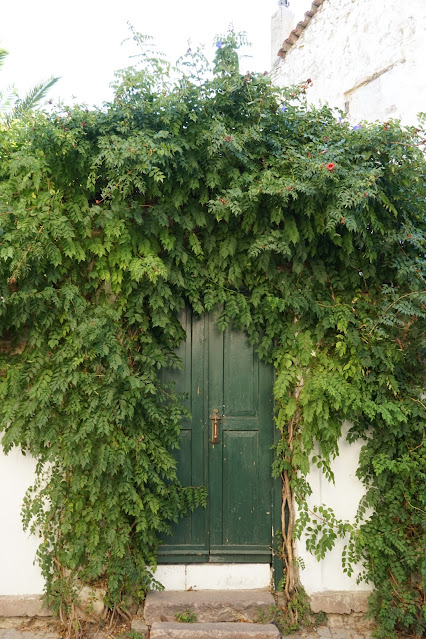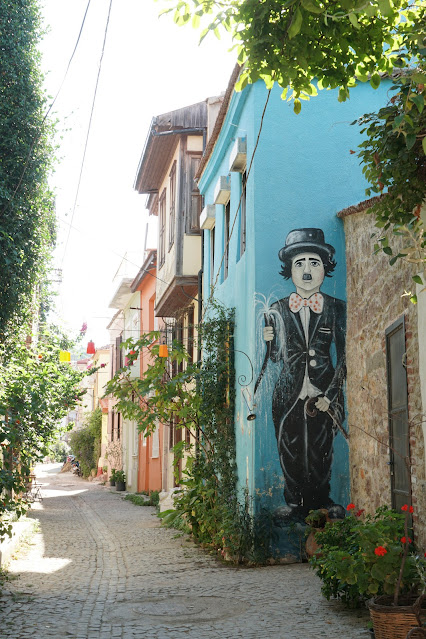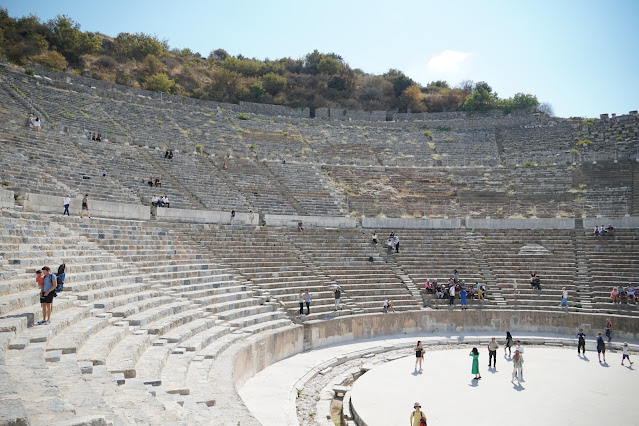I walked to the central Bodrum bus station, got on a bus and returned to main but station. Bus ticket can be paid with credit card, TL5. There were limited option of buses from Bodrum to Selçuk. My ticket departed Bodrum at 5:30pm, and the journey took about 3+ hours, TL120.
I had lunch but wasn't organise enough to pack dinner or snack. I got a packet of biscuit and one of those cake in a packet from a service station on one of the toilet breaks. I rushed but unfortunately was the last person who walked to the bus. Last person who walked to the bus but not the last one who got on it because all the smokers were standing around the bus and getting their dose of cigarettes. So I wasn't late, maybe they were even hoping I took longer. I thought the conductor would do a round of head count as I saw they were marking on a piece of paper but one of the travellers I met told me that he almost got left behind when he took longer in the bathroom. Luckily his friend was on the bus.
On arrival in Selçuk, I got my next bus ticket and walked to the hotel that I have made reservation. As I followed the route on Google maps, I felt that I have made a mistake with my choice of accommodation. When I was researching on Selçuk, I read that it was a nice place to walk around but my walk to the hotel were along a highway. I suspect maps must've prompted the Ephesus Archaeological Museum instead of the Ephesus Archaeological Site when I typed direction from Ephesus. Rookie mistake, especially so many of the shops have reference to the word Ephesus.
From the initial 1km or so walk that I thought I have to make to Ephesus, it turned into 4km. I was told there are buses but I didn't seem to notice any on my walk but maps probably led me on a non bus route trail.
 |
| Non-bus route like this... |
I had 1.5 days in Selçuk and the only item on my itinerary was Ephesus Ancient City, which I gathered was more than enough. I would probably also have enough time to make a trip to Sirince, which I didn't end up going but were raved by the Australian boys I met later in Çanakkale.
 |
| On my walk to Ephesus |
My impression is that Turkish were super friendly. Usually my conversation with strangers stopped at greetings of good morning, but somehow the conversations I had with Turkish went longer. The reason I didn't have enough time to trek to Sirince was the longer than expected conversations I had with the locals, watching them playing backgammon and they tried to teach me unsuccessfully, they offered me tea, and Turkish coffees, dinner and Raki drinks and I tried to repay with some baklavas. This was when I realised when Turkishs buy baklava, they buy a lot!
Although I didn't make it to Sirince, I did make it to Ephesus.
Ephesus
Ephesus or Efes as it is known in Turkish is one of the greatest ruined city in the Western world. A Greek city was first built here in about 1000 BC. The city we see today was founded in the 4th century BC by Lysimachu, Alexander the Great's successor. Ephesus became the chief port of the Aegean under the Romans. It was also mentioned that Ephesus attracted Christian settlers, including St John, who supposedly settled here with the Virgin Mary after the death of Jesus and wrote his gospel here.
I got a combined ticket, TL350 that covers entrance to the archaeological site, terrace houses, museum and Basilica of St. John. The main attraction that I want to go was the Terrace Houses but the ticket came in a bundle, single entry but valid for 72 hours from date of purchase.
I entered via the Upper Gate (Magnesian Gate), just because the route I took is nearest to this gate. Here are some more notable sights.
Temple of Hadrian
It was impossible to get a shot of the whole of the door without anyone standing in front of it, at least at the time of my visit. Temple of Hadrian was built to honour a visit by Emperor Hadrian in AD 123. The relief marble on the facade portrays mythical gods and goddesses.
Terraced Houses
This was a roofed complex so the colour of the photos are more of yellowish hues. In this complex, there are 7 well-preserved Roman homes built on three terraces. Terraced Houses are homes of wealthy locals. It gives oe a glimpse into the everyday lives of ancient Ephesians.
It was a one-way in and one-way out complex, on existing the area, one get an elevated view of Ephesus.
Library of Celsus
The third largest libarry in the ancient world (after Alexandria and Pergamum), it was designed to protect its 12,000 scrolls from extremes of temperature and moisture. This library dated from early 2nd century AD with facades of the Four Virtues. From left to right are Sophia (Wisdome), Arete (Goodness), Ennoia (Thought) and Episteme (Knowledge).
Theatre
Said to be carved into the flank of Mount Pion during the Hellenistic period. It was renovated later by the Romans.
Grotto of the Seven Sleepers
After exiting the Ephesus, I walked to the Grotto of the Seven Sleepers. Legend has it that seven young legendary Christians who lived in the reign of Emperor Decius around 250 AD refused to sacrifice to the temple. Defying the emperor, they hid in a cave. The young men fell asleep after awhile.
When they awoke from their sleep, they went into the town to buy food and upon paying, realised that they have slept for 200 years when the coins used to pay were from a different time. When they fell asleep again, they never woke up.
As there are damages to the structure of the cave, entrance is prohibited.
The Basilica of St. John
The youngest of the 12 Apostles of Jesus, St John arrived at Ephesus (known as Asia Minor then) after leaving Jerusalem to avoid prosecution after the death of Jesus. It is believed that he brought Virgin Mary ("Meryem" in the Koran) with him. It is believed that St John wrote the book "Book of Revelation" in or around Ephesus except for the time when he was exiled on a nearby island of Patmos.
Upon his death in Ephesus, a memorial monument was erected over his grave at the foot of Ayasuluk Hill. In the 4th century, a great basilica was built over St John's tomb by Roman emperor, Constantine. Later in the 6th century, an even more magnificient basilica was built over the earlier structure by Roman emperor Justinian.
Ayasuluk Fortress
This fortress is accessible with the same St. John of Basilica ticket, it kind of is within the same compund. Excavations done showed that there were castles on Ayasuluk Hill back in the Neolithic age.
Isa Bey Camii
This post-Seljuk/pre-Ottoman mosque can be found at the southern base of Ayasuluk Hill. Said to be built in 1375. It wasn't open at the time of my visit which was in the morning, and I can't read to understand the sign put up. Photos were taken from outside the gate.
After leaving the mosque, the plan was to visit the Temple of Artemis and then the Ephesus Museum before leaving Selçuk. The thing I found out about walking in Selçuk was everybody was so friendly that I kept on being stopped in my tracks.
Someone said hi, I responded by a good morning. He asked if I was going to the Ephesus, I said no, but going to the Temple of Artemis. It went on to him wanting to introduce one of his guest from Australia to me who happened to be having a coffee at the coutyard of his hotel -
Casa Kallinos. This then proceeded to him inviting me to have breakfast which I declined as I already had breakfast at the hotel, then he brought me promegranate juice and tea, also gave me a fresh fig to take away as someone had just delivered figs to his hotel.
Temple of Artemis
 |
| Taken from Basilica of St. John |
 |
| No stork spotted |
I visited this the morning before I left Selçuk, giving a full day to roam around Ephesus. On my walk to Ephesus, one of the locals struck a conversation with me. He told me he was heading to the Temple of Artermis and he sells books for work. At a turning, he went on his way to the Temple of Artermis and I continued to Ephesus.
The next day, when I arrived at the Temple of Artemis, the very same person came to approach me and said hi. He was selling souvenir books! It also means that I am super recognisable.
I was told that the spot where this single column is found wasn't the original locatoin for the initial temple. The initial temple was maybe about 500 metres away. I am not sure if this is true as I can't seem to find anything that mentioned this.
Ephesus Museum
I also made it to the Ephesus Museum, since I have already paid for it. It was an informative museum though I was a little surprise that it was smaller than what I expected. I even backtracked a little to make sure I didn't miss any room.
Side note: I have higher affinity to Ephesus' Turkish name of Efes.


























.jpg)




























